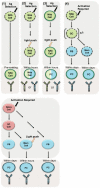Defining Natural Antibodies
- PMID: 28798747
- PMCID: PMC5526850
- DOI: 10.3389/fimmu.2017.00872
Defining Natural Antibodies
Abstract
The traditional definition of natural antibodies (NAbs) states that these antibodies are present prior to the body encountering cognate antigen, providing a first line of defense against infection thereby, allowing time for a specific antibody response to be mounted. The literature has a seemingly common definition of NAbs; however, as our knowledge of antibodies and B cells is refined, re-evaluation of the common definition of Nabs may be required. Defining Nabs becomes important as the function of NAb production is used to define B cell subsets (1) and as these important molecules are shown to play numerous roles in the immune system (Figure 1). Herein, we aim to briefly summarize our current knowledge of NAbs in the context of initiating a discussion within the field of how such an important and multifaceted group of molecules should be defined.
Keywords: B cell subsets; B cells; B-1 cells; antibodies; natural antibody; natural antibody repertoire.
Figures


References
-
- Michael JG. Natural antibodies. Curr Top Microbiol Immunol (1969) 48:43–62. - PubMed
LinkOut - more resources
Full Text Sources
Other Literature Sources

